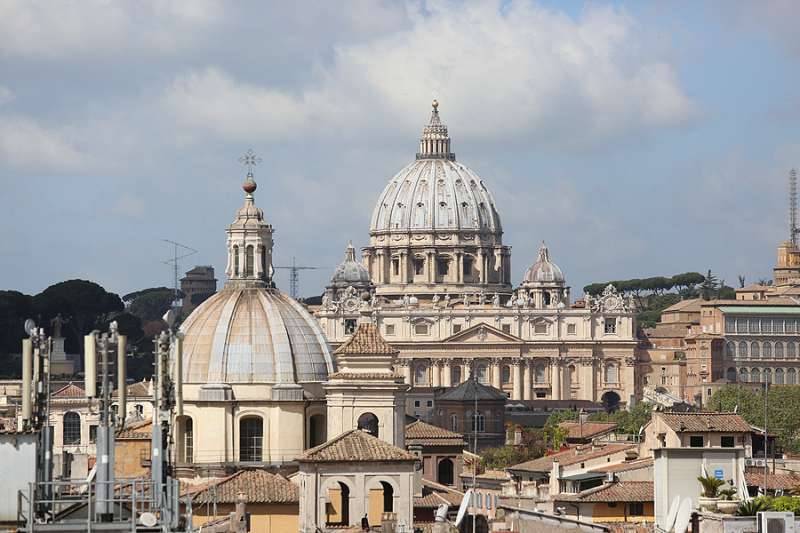Pope Francis’ announcement of a consistory to create new cardinals will also have consequences for the offices of the Roman Curia.
Archbishop Giovanni Angelo Becciu, Substitute for General Affairs in the Secretariat of State, has been appointed prefect of the Congregation of the Cause of Saints, to replace Cardinal Angelo Amato, who will turn 80 on June 8.
Substitute for General Affairs - sometimes referred to as the deputy - is the number two position in the Secretariat of State. Archbishop Becciu will cease to hold that role as of June 29, 2018, and Pope Francis will have to appoint a new deputy for the Secretariat, currently headed by Cardinal Pietro Parolin.
It was noteworthy that Pope Francis had a private audience May 19 with Archbishops Gabriele Giordano Caccia and Nicola Girasoli, apostolic nuncios to the Philippines and Peru, respectively.
Archbishop Caccia has long been considered a possible candidate for the Secretariat of State number two position, as he worked alongside Cardinal Parolin in the ranks of the Secretariat of State: while Cardinal Parolin was serving as Vatican Vice Minister of Foreign Affairs, Archbishop Caccia was the assessor of the Secretariat of State.
Cardinal Parolin and Archbishop Caccia were then appointed together as nuncios to Venezuela and to Peru, respectively, and were ordained bishops together by Benedict XVI on Sep. 12, 2009.
Archbishop Caccia was made nuncio to the Philippines on Sep. 12, 2017.
Archbishop Nicola Girasoli was appointed nuncio to Peru in 2017. A diplomat since 1985, he worked in the Apostolic Nunciature to Indonesia and Australia, then he spent a period in the Vatican Secretariat of State before working in the Apostolic Nunciatures to Hungary, Belgium, the United States and Argentina. He was then appointed nuncio to Zambia and Malawi (2006-2011), to Trinidad and Tobago (2011-2017) and to Peru.
He is considered very close to Pope Francis, and agreeable to Cardinal Pietro Parolin. Rumors suggest that he could be the most qualified to be the new deputy.
However, the reshuffle in the State Secretariat has already started, with a new head of protocol in the person of Msgr. Joseph Murphy, who replaced Archbishop Avelino Bettencourt, promoted nuncio to Armenia and Georgia.
Looking more broadly, all the Vatican dicasteries will likely experience a substantial reshuffle. There are 10 dicasteries whose presidents and prefects are expected to be approaching retirement.
Cardinal Angelo Amato, prefect of the Congregation for the Cause of Saints, is 79; Cardinal Lorenzo Baldisseri, general secretary of the Synod of Bishop, is 77; Cardinal Geroge Pell, prefect of the Secretariat for the Economy, is 76; Cardinal Beniamino Stella, prefect of the Congregation for the Clergy, is 76; Cardinal Giuseppe Bertello, president of the Vatican City State Administration, is 75; Cardinal Gianfranco Ravasi, president of the Pontifical Council for the Culture, is 75; Cardinal Domenico Calcagno, president of the Administration for the Patrimony of the Apostolic See, is 75; Archbishop Marcelo Sanchez Sorondo, chancellor of the Pontifical Academies for Science and Social Science, is 75; Msgr. Piero Marini, president of the Pontifical Committee for the International Eucharistic Congresses, is 76; and Fr. Pio Vito Pinto, dean of the Tribunal of the Roman Rota, is 76.
Until now, Cardinal George Pell and Cardinal Giuseppe Bertello had a prorogation of the post: Cardinal Pell will stay in charge until 2019, Cardinal Bertello will keep the post until 2021. Archbishop Sanchez Sorondo’s term has also been prolonged, while Cardinal Amato will turn 80 and will leave the post.
There is, then, room for Pope Francis to initiate a substantial reshuffle. There are also still some key positions vacant: the undersecretary for the family in the Dicastery for Laity, Family and Life; the promoter of justice in the Tribunal of the Roman Rota; and the prefect of the Secretariat for Communication.
It is worth noting that the Secretariat for Communication has changed its name to the “Dicastery of Communication,” and new badges are being delivered to the employees.
This means that the Secretariat has been lowered in rank: it is no longer on par with the Secretariat of State, but is merely one of the dicasteries that will compose the Roman Curia after the Curia reform is completed.
It is likely that the post of Prefect of Communication will remain vacant. The former prefect, Msgr. Dario Edoardo Vigan√≤, resigned March 21, and was then appointed by Pope Francis as “assessor” of the Secretariat for Communication.
Just a few days later, the webpage of the Secretariat for the Communication included the post of “assessor” in the Secretariat’s organizational chart, although the post is not listed in the dicastery’s statute, from Sep. 6, 2017.
While the post of Prefect of the Secretariat is described as “vacant,” the post of assessor was listed as number 3 in the ranks.
The organizational chart does not mention the Editorial Direction, which Msgr. Viganò chaired ad interim. The Editorial Direction is still included in the statute, but it is not listed in the organization chart.
Msgr. Lucio Adrian Ruiz, the secretary of the Vatican’s communications office, is acting as interim prefect.
These are not just details, but rather offer some insight into the reform process.
In several articles written for Italian magazine “Il Regno,” Bishop Marcello Semeraro explained that Pope Francis wants reforms to be made “while walking.”
This means that there is no framework that provides a guideline for the reforms. Rather, the reforms themselves will provide the framework.
This is the opposite of what happened when St. John Paul II issued Pastor Bonus, the Apostolic Constitution that regulates functions and tasks of the Roman Curia offices. That text was issued in 1988, and was widely discussed for years before. The changes were implemented according to the text.
In this case, the final text of a new pastoral constitution will reflect the changes made, and only then will it be possible to get a general overview of the reforms that have been done.

